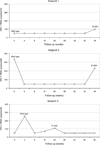Emerging integrase inhibitor resistance mutations in raltegravir-treated HIV-1-infected patients with low-level viremia
- PMID: 21326075
- PMCID: PMC3265637
- DOI: 10.1097/QAD.0b013e3283445834
Emerging integrase inhibitor resistance mutations in raltegravir-treated HIV-1-infected patients with low-level viremia
Abstract
Background: The emergence of integrase strand-transfer inhibitor (INSTI) resistance-associated mutations was examined in patients with low-level viremia after switching from enfuvirtide to raltegravir in the ANRS 138-Easier trial.
Methods: Integrase genes of plasma virus from raltegravir-treated patients in the Easier trial with low-level viremia (50-500 copies/ml) were sequenced to determine INSTI resistance-associated mutations. Baseline viral load, baseline and nadir CD4 cell count, antiretroviral treatment, genotypic susceptibility score, level of viremia and degree of treatment adherence during the study period were also analyzed.
Results: Forty-nine patients experienced at least one episode of low-level viremia while receiving raltegravir; integrase genotyping was successful in samples from 39 individuals (80%). Among them, three [7.7%, 95% confidence interval (CI) 1.6-20.9%] had significant INSTI resistance mutations consisting of N155H in two and P145S in one. Absence of these mutations from proviral DNA at baseline suggested selection of INSTI resistance during episodes of low-level viremia. No specific factors significantly associated with emergence of INSTI resistance mutations during low-level viremia were identified.
Conclusion: Emergence of INSTI resistance mutations can occur during episodes of low-level viremia in patients receiving raltegravir-containing regimens.
Figures
Similar articles
-
Evaluation of HIV-1 integrase resistance emergence and evolution in patients treated with integrase inhibitors.J Glob Antimicrob Resist. 2020 Mar;20:163-169. doi: 10.1016/j.jgar.2019.07.015. Epub 2019 Jul 19. J Glob Antimicrob Resist. 2020. PMID: 31330378
-
HIV-2 integrase polymorphisms and longitudinal genotypic analysis of HIV-2 infected patients failing a raltegravir-containing regimen.PLoS One. 2014 Mar 28;9(3):e92747. doi: 10.1371/journal.pone.0092747. eCollection 2014. PLoS One. 2014. PMID: 24681625 Free PMC article.
-
HIV-1 resistance patterns to integrase inhibitors in antiretroviral-experienced patients with virological failure on raltegravir-containing regimens.J Antimicrob Chemother. 2010 Jun;65(6):1262-9. doi: 10.1093/jac/dkq099. Epub 2010 Apr 12. J Antimicrob Chemother. 2010. PMID: 20388636
-
HIV resistance to raltegravir.Eur J Med Res. 2009 Nov 24;14 Suppl 3(Suppl 3):47-54. doi: 10.1186/2047-783x-14-s3-47. Eur J Med Res. 2009. PMID: 19959417 Free PMC article. Review.
-
Characterization and structural analysis of HIV-1 integrase conservation.AIDS Rev. 2009 Jan-Mar;11(1):17-29. AIDS Rev. 2009. PMID: 19290031 Review.
Cited by
-
The significance of low-level viraemia in diverse settings: analysis of the Treat Asia HIV Observational Database (TAHOD) and the Australian HIV Observational Database (AHOD).HIV Med. 2014 Aug;15(7):406-16. doi: 10.1111/hiv.12124. Epub 2014 Jan 26. HIV Med. 2014. PMID: 24460817 Free PMC article.
-
Prevalence and significance of HIV-1 drug resistance mutations among patients on antiretroviral therapy with detectable low-level viremia.Antimicrob Agents Chemother. 2012 Nov;56(11):5998-6000. doi: 10.1128/AAC.01217-12. Epub 2012 Aug 13. Antimicrob Agents Chemother. 2012. PMID: 22890763 Free PMC article.
-
Genotypic Resistance Testing of HIV-1 DNA in Peripheral Blood Mononuclear Cells.Clin Microbiol Rev. 2022 Dec 21;35(4):e0005222. doi: 10.1128/cmr.00052-22. Epub 2022 Sep 14. Clin Microbiol Rev. 2022. PMID: 36102816 Free PMC article. Review.
-
HIV drug resistance detected during low-level viraemia is associated with subsequent virologic failure.AIDS. 2014 May 15;28(8):1125-34. doi: 10.1097/QAD.0000000000000203. AIDS. 2014. PMID: 24451160 Free PMC article.
-
Comparison of HIV-1 viral load assay performance in immunological stable patients with low or undetectable viremia.Med Microbiol Immunol. 2013 Feb;202(1):67-75. doi: 10.1007/s00430-012-0249-y. Epub 2012 Jun 15. Med Microbiol Immunol. 2013. PMID: 22699843
References
-
- Lennox JL, DeJesus E, Lazzarin A, Pollard RB, Madruga JV, Berger DS, et al. Safety and efficacy of raltegravir-based versus efavirenz-based combination therapy in treatment-naive patients with HIV-1 infection: a multicentre, double-blind randomised controlled trial. Lancet. 2009;374:796–806. - PubMed
-
- Steigbigel RT, Cooper DA, Kumar PN, Eron JE, Schechter M, Markowitz M, et al. Raltegravir with optimized background therapy for resistant HIV-1 infection. N Engl J Med. 2008;359:339–354. - PubMed
-
- Cooper DA, Steigbigel RT, Gatell JM, Rockstroh JK, Katlama C, Yeni P, et al. Subgroup and resistance analyses of raltegravir for resistant HIV-1 infection. N Engl J Med. 2008;359:355–365. - PubMed
-
- Eron JJ, Young B, Cooper DA, Youle M, Dejesus E, Andrade-Villanueva J, et al. Switch to a raltegravir-based regimen versus continuation of a lopinavir-ritonavir-based regimen in stable HIV-infected patients with suppressed viraemia (SWITCHMRK 1 and 2): two multicentre, double-blind, randomised controlled trials. Lancet. 2010;375:396–407. - PubMed
-
- De Castro N, Braun J, Charreau I, Pialoux G, Cotte L, Katlama C, et al. Switch from enfuvirtide to raltegravir in virologically suppressed multidrug-resistant HIV-1-infected patients: a randomized open-label trial. Clin Infect Dis. 2009;49:1259–1267. - PubMed
Publication types
MeSH terms
Substances
Grants and funding
LinkOut - more resources
Full Text Sources
Medical
Research Materials


